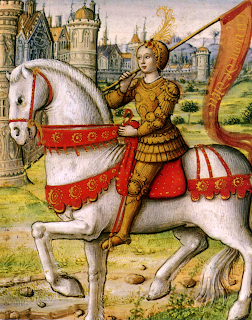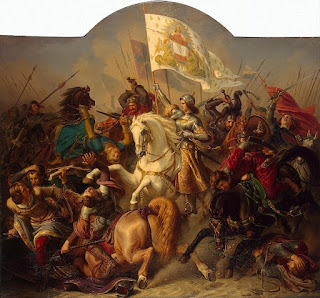One famous case was that of Joan of Arc, who was tried for heresy and sorcery and burnt at Rouen in 1431.
 |
| Joan Of Arc |
In 1429 this young peasant girl introduced herself to Charles, the Dauphin of France, as his God-given saviour, telling him that she could change his fortune in the war against the English.
She said that a voice from God had told her to raise the siege of Orleans to help Charles recover his kingdom and drive the English out of France.
From the age of 12, Joan had seen visions, heard the voices of the Archangel Michael, Catherine of Alexandria and Margaret of Antioch and made prophecies according to what they had to say.
The Duke of Bedford, who commanded the English forces at the siege of Orleans, attributed English losses to the unlawful supernatural forces deployed by Joan of Arc, and called her a 'discipline of the Fiend' who used false enchantment and sorcery.
Shakespeare described the two views of Joan in Henry VI, part 1 - as a French pattron saint:
No longer on St Denis will we cry, but Joan la Pucelle shall be Franceis saint.And as a heretic:
Coward of France! How much he [the Dauphin] wrongs his fame....
To join with witches and the help of hell.
 |
| Joan of Arc in a Battle |
 Joan was brought before the Inquisition by the English for heresy and for her idolatry and the 'cult and veneration' of her saints, which was said to be part of a pact with the Devil. The tribunal was composed mainly of ecclesiastics and lawyers, sometimes numbering more than 70 men. She was taken to the cemetery of St Ouen in Rouen and placed on a scaffold, surrounded by cardinals, bishops and various earls, dukes and officials, while passages from John's Gospel, including the saying that 'the withered branch must be thrown in the fire else the tree cannot flourish', were shouted. There is much controversy surrounding what happened, but Joan signed a document of recantation and was condemned to lifelong imprisonment, on bread and water and in solitary confinement, because the Inquisition could not condemn to death a heretic, only a relapsed heretic.
Joan was brought before the Inquisition by the English for heresy and for her idolatry and the 'cult and veneration' of her saints, which was said to be part of a pact with the Devil. The tribunal was composed mainly of ecclesiastics and lawyers, sometimes numbering more than 70 men. She was taken to the cemetery of St Ouen in Rouen and placed on a scaffold, surrounded by cardinals, bishops and various earls, dukes and officials, while passages from John's Gospel, including the saying that 'the withered branch must be thrown in the fire else the tree cannot flourish', were shouted. There is much controversy surrounding what happened, but Joan signed a document of recantation and was condemned to lifelong imprisonment, on bread and water and in solitary confinement, because the Inquisition could not condemn to death a heretic, only a relapsed heretic.When Joan withdrew her declaration, saying that she was still hearing voices, the way was open for her inquisitors to put an end to what they saw as her communication with evil spirits. When she went to the stake she wore over her shaven head a tall mitre that was inscribed with her crimes and the names of her malign spirits - Belial, Satan and Behemoth.
0 comments:
Post a Comment